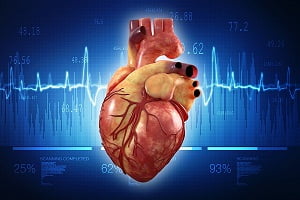
What is myocardial infarction (heart attack)?
Myocardial infarction is commonly known as ‘heart attack’. It is the most common heart condition experienced by people across the world. A myocardial infarction is a life threatening heart condition in which the heart muscles experience sudden cut in oxygenated blood supply that results in the damage of heart tissues.
The heart is one of the organs which constantly work from birth of a child till his or her death. It supplies oxygenated blood to all the parts of the body and deoxygenated blood to the lungs for purification. For working efficiently and smoothly, the heart requires constant supply of oxygenated blood and nutrients to its muscles.
The coronary arteries are responsible for the constant supply of blood and nutrients to the heart muscles. Any blockage or clot in these blood vessels reduces or completely cuts the blood supply to the heart and results in its tissue damage. This condition is known as myocardial ischemia. If this condition occurs for a very long time, then there is a very high chance of having a heart attack or myocardial infarction.
According to a report, approximately 1.5 million cases of myocardial infarction are registered every year in the United States.
What are the different types of myocardial infarction?
Myocardial infarction can be classified on the basis of ECG measurement commonly known as ST segment. Some common types of myocardial infarction or heart attacks are:
Acute coronary syndrome
Acute coronary syndrome or ACS is a type of heart attack in which the coronary arteries are blocked. There are three types of ACS, namely:
STEMI
STEMI is also known as ST segment elevation myocardial infarction and is the most serious form of heart attack. In this condition, a long interruption in the blood supply is observed due to the total blockage of the coronary artery.
NSTEMI
NSTEMI is also known as Non-ST segment elevation myocardial infarction. This condition is less serious as compared to STEMI as the blockage of blood to the heart is blocked only partially. In this case, only a small section of the heart is damaged. If untreated in time, this may result in the progression of STEMI.
Unstable angina
Unstable angina is a condition in which the blood supply to the heart is restricted but there is not any damage observed in the heart muscles. Generally, angina is not a very serious condition but if left untreated or unattended for a longer period of time, the condition may result in the occurrence of STEMI.
More: Complications Of Angina: Is Angina Serious?
What are the causes of myocardial infarction?
The most common cause of heart attack is atherosclerosis. Atherosclerosis is a condition in which the coronary arteries are hardened by the deposition of various types of fats, etc. A blood clot is the most common trigger for heart attack which limits or blocks the flow of blood to the heart.
There are certain substances that stick to the artery walls, creating plaques and making the path for blood flow very narrow. This results in the blockage of the arteries and reduces the supply of blood to the heart.
These plaques are made up of various substances such as:
Bad cholesterol
Bad cholesterol is also known as low-density lipoprotein (LDL). It is one of the main causes of a blockage in the coronary arteries.
Cholesterol is a colorless substance which is found in the food products such as butter, ghee, meat, etc. The human body also manufactures it naturally. Not all cholesterol is bad, but LDL cholesterol is very harmful as it sticks to artery walls and forms plaque.
Plaques are the hard substances which blocks the flow of blood in the arteries. Clotting agents, called blood platelets, also get stuck to these plaques and further blocks the whole artery.
More: Coronary artery disease
Saturated fats
Saturated fats also result in the formation of plaques in the coronary arteries. This type of fat is widely found in meat and dairy products, such as beef, butter, and cheese. This type of fat increases the amount of bad cholesterol in the blood and reduces the good cholesterol.
Trans fat
Another type of fat which results in plaque formation in the arteries is trans fat, or hydrogenated fat. Trans fat is not produced by the body and is consumed artificially from various food products such as vegetable oil, etc.
Apart from the above causes, there are various rare causes which are also responsible for the occurrence of myocardial infarction. Some of the other causes of heart attack ares:
- Inflammation in the coronary arteries
- Any complication due to heart surgery
- Consumption of cocaine
- A stab wound in the heart
More: Sharp Pain in Chest: What Does it Mean?
What are the risk factors of myocardial infarction?
Heart attacks are one of the most common heart conditions experienced by people all over the world. Generally, people above the age of 50 suffer from heart attack.
This condition is more common in men as compared to women. However, after menopause, the hormones in the woman are no longer able to protect her heart from such conditions due to which she is more prone to heart problems than in her younger age.
Some common risk factors that result in the heart attack are as follows:
- Smoking
- Stress
- Being overweight
- Constant high blood pressure
- High cholesterol level
- Physical inactivity
- Improper and unhealthy diet
- Diabetes
- Family history
People with high sugar levels in their blood are more prone to suffer from acute chest syndrome (ACS) as compared to healthy people.
What are the symptoms of myocardial infarction? How do I know when I am having a heart attack?
Myocardial infarction or heart attack can show different signs and symptoms in different individuals. The symptoms can either progress slowly or can even occur suddenly.
The most common symptom observed in a heart patient with myocardial infarction is chest pain or angina. Angina is referred to the frequent episodes of chest pain which result from ischemia.
In angina, the blood flow is restricted from flowing towards the heart for some duration of time but resumes afterwards. In case of heart attack, this blood flow is blocked for a very long period of time.
There are many other symptoms of heart attack such as:
- Sudden pain in back, chest, jaws and other body parts
- Shortness of breath
- Constant sweating
- Anxiety dizziness
- Cough
- Fast heart rate
- Vomiting
- Fatigue
- Chest discomfort
What are the complications of myocardial infarction? How dangerous is a heart attack?
Possible complications of a myocardial infarction or a heart attack can vary from person to person and also based on the level of attack, i.e. whether it is a mild heart attack or a major heart attack.
There are many complications associated with a heart attack. Some of them are as follows:
Arrhythmia
Arrhythmia is a heart condition in which the heart beats abnormally. Arrhythmia includes:
- Tachycardia- condition in which the heart beats too fast.
- Bradycardia- condition in which the heart beats very slowly
- Atrial fibrillation- condition in which the heart beats irregularly
More: Heart Rate By Age: What is a Good Heart Rate as You Age?
Heart attack causes damage to the muscles and results in arrhythmia. These damaged muscles result in the disruption of the electrical signals which are otherwise used by the body to control the working of heart.
Some common symptoms of arrhythmia are:
- Chest pain
- Palpitations
- Dizziness
- Fatigue or tiredness
- Shortness of breath
Arrhythmia can result in complete heart blockage or a cardiac arrest.
Heart failure
Heart failure is a heart condition in which the heart is unable to pump blood effectively around body. This condition usually occurs in the left side of the heart when the heart muscles are severely damaged due to a heart attack.
Some common symptoms of heart failure are as follows:
- shortness of breath
- swelling in the limbs due to fluid build-up
- fatigue
Cardiogenic shock
Cardiogenic shock is a condition in which the heart muscles are damaged to such an extent that it is no longer able to pump blood to a specific part of the body.
Some common symptoms of cardiogenic shock are:
- cold hands and feet
- pale skin
- decreased urine output
- mental confusion
- rapid breathing and heartbeat
Heart rupture
Heart rupture is a rare but extremely serious heart condition in which the heart muscles permanently rupture which generally results in the death of the patient.
This condition occurs when the heart muscles are severely damaged for more than 5 days after a heart attack.
How is myocardial infarction diagnosed? Tests for diagnosing heart attack
As soon as the symptoms of heart attack are observed in a person, he should immediately consult a doctor for proper diagnoses. The doctor may admit the patient and run some diagnostic tests to understand the current condition of heart.
Some most common diagnostic techniques are as follows:-
Electrocardiography
An electrocardiography machine is an instrument which helps in measuring the electrical activity of the heart. The heart beat produces tiny electrical impulses which are recorded by an ECG machine onto a paper, allowing the doctor to see the heart functioning.
An ECG is a painless test that takes about five minutes to perform and give the results. During the test, electrodes are attached to the chest, arms and legs of the patient. The electrodes are attached to the ECG machine by wires and records the electrical impulses.
This test should be performed within 10 minutes of admission to the hospital. This test helps in confirming the occurrence of a heart attack and the type of heart attack the patient have experienced.
Blood test
When the heart is damaged due to heart attack, certain types of proteins or enzymes slowly leak into the blood stream. These enzymes are referred to as cardiac marker and a blood test is required for recognizing their presence. The most common cardiac marker found in blood after a heart attack is troponin.
Echocardiogram
Echocardiogram is a test that is used to study the pumping of heart after a heart attack and to identify any abnormality in its pumping.
Chest x-ray
A chest X-ray is recommended when the diagnosis of myocardial infarction is not confirmed and there may be other possible reasons of the symptoms, such as pneumothorax.
Coronary angiography
Coronary angiography is a test used to determine any blockage in the coronary arteries and its location. In this test, a thin tube, called a catheter, is inserted into the blood vessels through the groin or arm.
This catheter is guided into the coronary arteries of the patient with the help of X-rays. A fluid-called contrast agent is flowed through the catheter whose flow is studied on the x-ray. With the help of the fluid, any blockage in the arteries and its position can be seen on the display machine.
More: What Are Abnormal Heart Sounds (Heart Murmurs)?
How is myocardial infarction treated? How can heart attacks be treated?
As soon as the heart attack is diagnosed, quick treatment options should be opted for preventing the heart from further damage. There are various methods or techniques for the proper treatment of heart attack.
Some of the techniques are as follows:
Medications
Medicines are the most common method for treating any complication. In case of myocardial infarction, medicines are basically used for preventing the blood platelets form sticking together and forming a plaque, preventing a blood clot, managing pain, etc.
Correct medicines should be given to the patient as soon as possible, generally within 30 minutes from the starting of a heart attack. Some common medicines prescribed for a heart attack are as follows:
- thrombolytic therapy or clot busters
- aspirin
- other antiplatelet drugs
- prasugrel
- bivalirudin
- heparin, etc
Coronary angioplasty
Coronary angioplasty is a technique of complex procedure requiring specialized staff and equipment. In case of a coronary angioplasty, a tiny tube called balloon catheter, fitted with a sausage-shaped balloon at the end, is inserted into a large artery in the patient’s arm or groin.
The catheter is then passed through the blood vessels up to the heart, with the help of x-rays to guide it. It is then moved to the narrow section of the targeted coronary artery.
Once the catheter reaches its position, the balloon in the balloon catheter is inflated inside the coronary artery to widen it. A flexible metal mesh, known as a stent is inserted into the artery to keep the artery open.
Coronary artery bypass graft
Coronary angioplasty technique fails tremendously when there are many narrow arteries or small blockages present in the arteries. In such cases, an alternate surgical procedure, called coronary artery bypass graft or CABG is used in which blood vessel from another organ such as chest is taken and used as a graft to replace the blocked artery.
In this technique, the surgeon takes a healthy blood vessel from a part of the body and attaches it to the aorta, beyond the narrowed artery.






